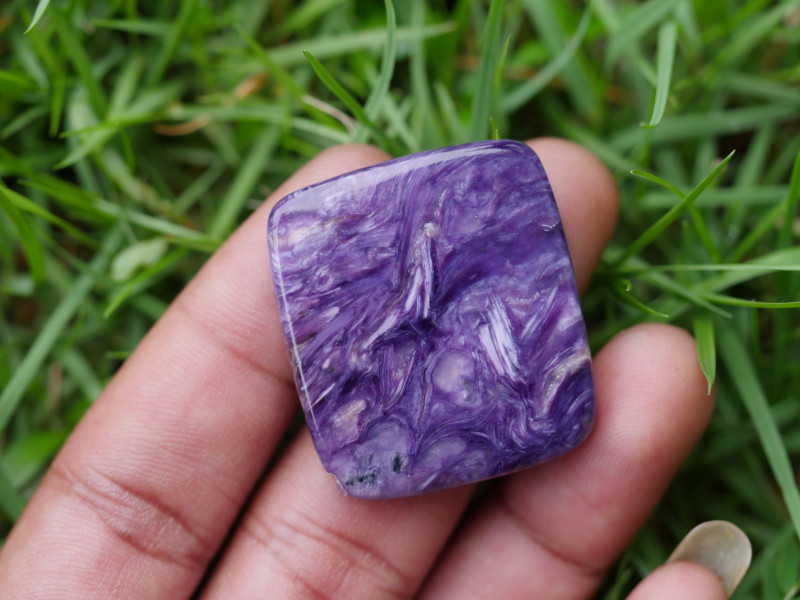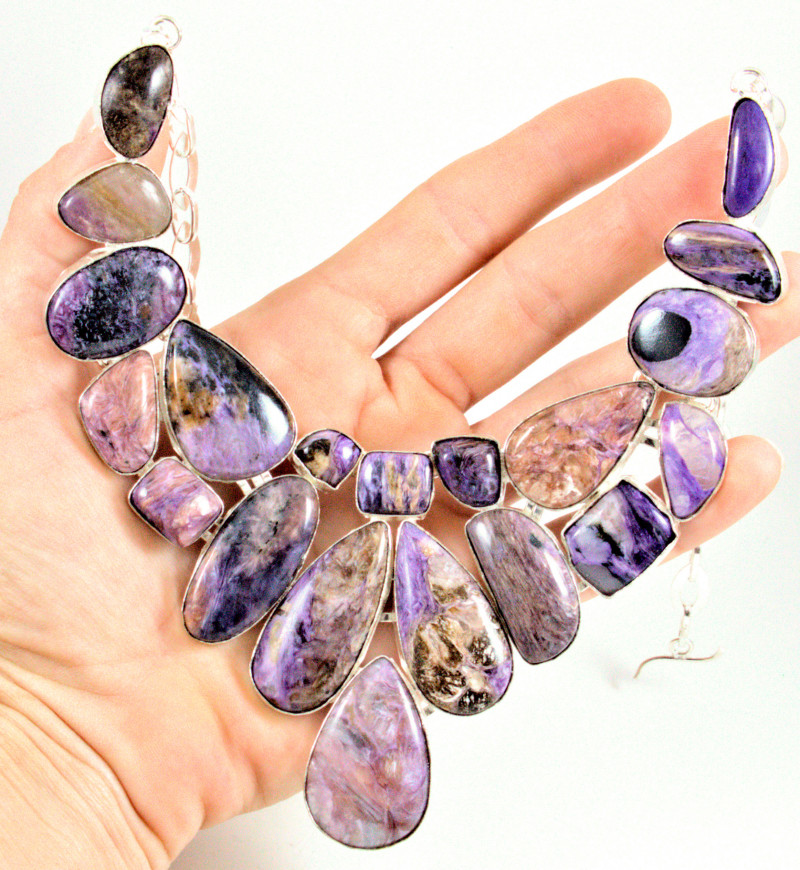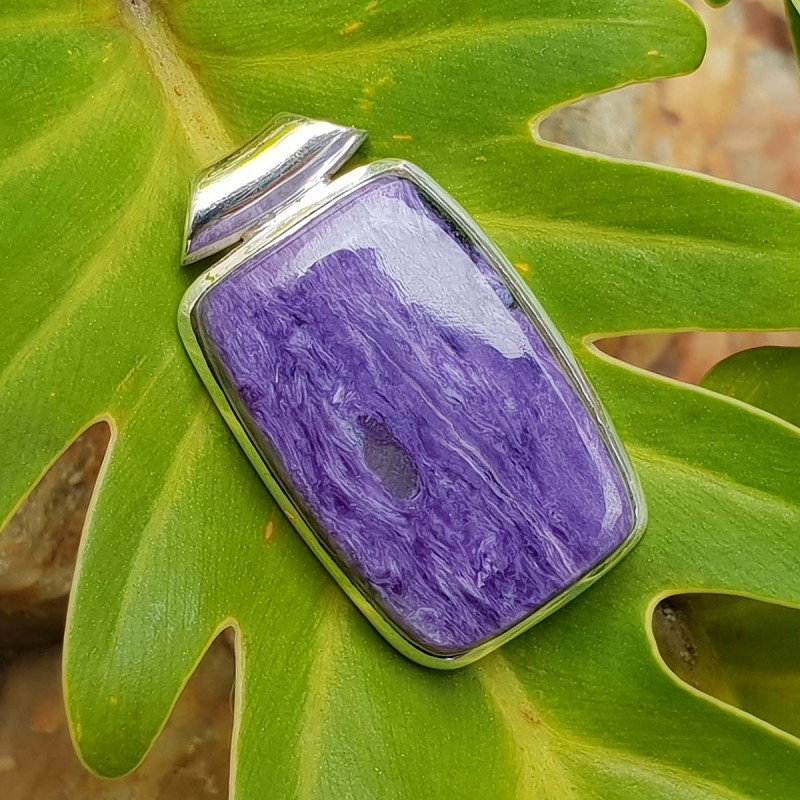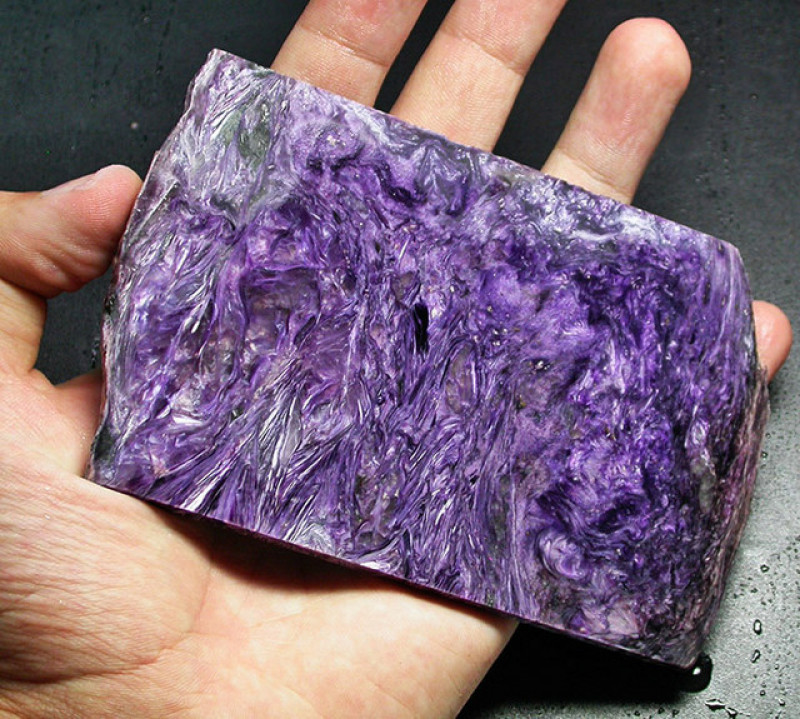
Charoiet edelsteen: betekenis, helende eigenschappen, waarde en meer
 Charoiet is een unieke en zeldzame violette edelsteen die alleen in een gebied in Siberië, Rusland, wordt gevonden. Hij heeft verschillende tinten paars, vermengd met wit, zwart en soms andere kleuren. Omdat de exacte mineralen en hun concentratie in elke steen variëren, is elke charoiet volkomen uniek!
Charoiet is een unieke en zeldzame violette edelsteen die alleen in een gebied in Siberië, Rusland, wordt gevonden. Hij heeft verschillende tinten paars, vermengd met wit, zwart en soms andere kleuren. Omdat de exacte mineralen en hun concentratie in elke steen variëren, is elke charoiet volkomen uniek!
Eén belangrijk onderscheid om te kennen: charoiet mineraal versus charoiet gesteente.
Ooit gehoord van lapis lazuli ? Net als die hemelsblauwe edelsteen wordt charoiet alleen in zijn gesteentevorm gebruikt voor edelstenen. Charoiet edelstenen bestaan echter bijna volledig uit het mineraal charoiet, terwijl het mineraal lazuriet minder dan de helft van lapis lazuli bevat.
Maar terug naar charoiet: vandaag leert u alles wat deze edelsteen zo bijzonder maakt, waaronder de genezende eigenschappen van charoiet, de prijzen, de symboliek en nog veel meer.

Wat is Charoiet?
Charoiet is een prachtige, maar grotendeels onbekende halfedelsteen . Hij wordt ook wel 'de Siberische steen', 'charoiet jade' of 'seringsteen' genoemd.
Deze unieke edelsteen zou je kunnen verwarren met sugiliet . Sugiliet heeft echter een gelijkmatigere kleur, geen duidelijke wervelingen en mist een eenvoudige chatoyantie (vergelijkbaar met het "kattenoog"-effect).
Charoiet heeft een zo kenmerkend uiterlijk dat edelsteenkundigen de steen meestal al op basis van het uiterlijk kunnen identificeren. Dat is een zeldzame eigenschap voor edelstenen!
Deze edelsteen is een natuurlijke geboortesteen voor mensen die rond de winterzonnewende (de data voor Steenbok van 21 december tot 19 januari) geboren zijn. Het is ook een sterrenbeeldsteen voor Tweelingen, Schorpioen en Boogschutter. Bovendien is het een planetaire sterrensteen voor Venus.

Charoiet specificaties en kenmerken
De samenstelling van charoiet is uiterst complex; zelfs betrouwbare bronnen verschillen van mening over de exacte formule. Alleen al de beschrijving ervan is een hele mond vol: een gehydrateerde kalium-, natrium-, calcium-, barium-, strontium- en silicaathydroxyfluoride. Poeh!
Hoewel de technische term voor de charoietrijke rotsen die voor edelstenen worden gebruikt 'charoitiet' is, noemen edelsteenkundigen ze nog steeds 'charoiet'.
De charoietkristallen in deze rotsen zijn vezelachtige massa's. Ze vormen een systeem van ingewikkelde, verweven patronen, wat resulteert in het wervelende uiterlijk en de textuur van de edelsteen.
Charoietgesteenten bevatten ook kleine hoeveelheden andere mineralen, meestal zeldzame. Sommige hiervan kunnen verschillende texturen creëren. Benstonietmineralen bijvoorbeeld leiden tot parallelle vezels, terwijl tinaksiet- en canasietmineralen een radiale vezeltextuur veroorzaken.
Bekijk ook de overige eigenschappen van charoiet:
Mohs-hardheid : 5-6
Kleur : Paarse tinten, waaronder violet en lila-roze, of bruin; Bijna altijd patronen in wit, zwart en mogelijk oranje, groen, grijs en/of roze
Kristalstructuur : Monoklinisch
Glans : Glasachtig tot parelmoerachtig
Transparantie : doorschijnend tot ondoorzichtig
Brekingsindex : 1,55-1,56
Dichtheid : 2,54 - 2,58
Splijting : redelijk tot goed
Breuk : Splinterigheid
Streak : Wit
Luminescentie : Soms zwakke fluorescentie; Blauw, rood of groen in SW-UV
Pleochroïsme : Duidelijk te onderscheiden in kleurloos tot rozerood
Optische effecten : Soms chatoyancy
Soorten Charoiet
Er bestaan geen specifieke soorten charoiet, maar er zijn een paar namen die in de industrie worden gebruikt en die u moet kennen:
Beam Charoiet : Paarse charoiet met een uniforme, diep lila kleur en sterke irisatie. Het lage gehalte aan niet-charoiet mineralen (minder dan 15 procent) maakt het de meest geliefde steen voor charoiet sieraden.
Spotty Beam Charoiet : Charoiet met het breedste kleurenspectrum, inclusief een paarse achtergrond met zwarte, goudgele en diepgroene vlekken. De kleuren kunnen ook schilderachtige patronen creëren, ook wel 'landschapscharoiet' genoemd.
Chatoyant Charoiet : De meest gewilde charoietsteen vanwege de dunne lichtbundels die op het oppervlak worden weerkaatst (eenvoudige chatoyantie).
Laten we nu verder gaan met de metafysische betekenis en geschiedenis van charoiet!

Betekenis en geschiedenis van Charoietsteen
De oorsprong van de naam charoiet is onderwerp van discussie. Velen beweren dat het verwijst naar de ontdekking van de steen nabij de rivier de Chara, maar de oorspronkelijke vindplaats lag in werkelijkheid zo'n 70 kilometer verderop.
De andere theorie is dat "charoiet" afkomstig is van het Russische woord chary , wat "bekoringen" of "magie" betekent. Een andere mogelijke oorsprong is de Proto-Slavische term chara , wat "beker" of "kom" betekent. Charoietbekers en -kommen waren inderdaad vroeger heel gebruikelijk.
De lokale bevolking van de Siberische republiek Sacha vond charoiet voor het eerst in de jaren 40 bij het Baikalmeer. Ze noemden het de "seringsteen" of soms "het seringwonder van Siberië" en genoten er decennialang exclusieve kennis van.
De eerste officiële beschrijving van charoiet kwam bijna 40 jaar later, maar charoiet moest zich eerst bewijzen om zover te komen. Meer dan tien jaar daarvoor dacht men dat de steen zo levendig en uniek was dat hij nep of geverfd moest zijn. In 1978 werd charoiet door de International Mineralogical Association (IMA) goedgekeurd als authentieke edelsteen.
Nadat de IMA de steen had goedgekeurd, brachten verkopers hem op de markt als 'charoiet'. De populariteit van charoiet verspreidde zich onder edelsteenkundigen en kristalgenezers.
In 2000 sierde deze paarse steen uit Rusland zelfs een speciale postzegel van de Euroasian Geophysical Society (EAGO) ter ere van "300 jaar mijnbouw en geologische dienstverlening in Rusland."
Charoiet symboliseert inzicht, transformatie en vrijgevigheid. Sommigen noemen het de "Wagen van de Hemel" en geloven dat het eenheid met het goddelijke vertegenwoordigt. Om deze reden maken veel spirituele beoefenaars, zoals wijzen en mediums, graag gebruik van de metafysische eigenschappen van charoiet.
En waar is charoiet eigenlijk goed voor?

De helende eigenschappen van Charoiet
Edelstenen zoals charoiet, vooral paarse edelstenen , zijn van nature spirituele helende stenen .
Gezien de symboliek van inzicht en intuïtie is het niet verrassend dat charoiet een krachtige chakrasteen is voor het openen van het derde oogchakra – het centrum van intuïtie, besluitvorming en spirituele wijsheid. Charoiet opent ook het hoogste centrum voor spiritualiteit: het kruinchakra!
Laten we eens kijken naar de voordelen van charoiet voor fysieke en emotionele genezing!
Lichamelijke genezing
Kristalgenezers geloven dat charoiet een groot aantal fysieke kwalen kan behandelen, waaronder:
Hoofdpijn of krampen
Hoge bloeddruk
Leverschade, vooral door chronisch alcoholgebruik
Slaapstoornissen
Oogproblemen
Hartaandoeningen
Hoe zit het met emotionele eigenschappen?
Emotionele genezing
Sommige mensen hebben een sterk instinct voor mensen, maar niet iedereen heeft zoveel geluk. Als je merkt dat je rode vlaggen over het hoofd ziet of liever wat scherper zou zijn, kan charoiet helpen. Het zou je een helderdere en sterkere intuïtie geven. Daarmee kun je duistere patronen herkennen om bedriegers te vermijden en te voorkomen dat je wordt opgelicht.
Bovendien blijkt uit psychologisch onderzoek dat vertrouwen op intuïtie je creativiteit kan vergroten, je besluitvorming kan versterken en je kan helpen een beter inzicht in jezelf te krijgen.
Andere voordelen die aan charoiet worden toegeschreven, zijn onder meer het verbeteren van het zelfrespect en zelfbewustzijn. De steen zou vergevingsgezindheid stimuleren, vooral tegenover jezelf. Als je een fout hebt gemaakt, kan charoiet je helpen de verantwoordelijkheid te nemen en verder te gaan met nieuwe inzichten.
Bent u bang dat u fouten maakt bij het kopen van charoiet? Lees dan verder om alle belangrijke factoren over de waarde van charoiet te ontdekken!

Eigenschappen van Charoiet Edelsteen
De waarde van charoiet hangt af van de standaardeigenschappen van edelstenen: kleur, slijpvorm, zuiverheid en transparantie. Chatoyancy is echter een andere belangrijke waardefactor.
Kleur
Paarse en roze charoiet vertonen een breed scala aan tinten: lavendel, lila-roze, magenta, violet en koningspaars. Deze tinten zijn te danken aan het hoge mineraalgehalte van charoiet.
Witte patronen komen meestal van kwarts, calciet of witte veldspaat . Zwarte patronen komen vaak van mangaandioxide, aegirien en donkergroene veldspaat. Andere kleurstrepen zijn oranje of geelbruin van tinaksiet en groengrijs van microklien veldspaat.
Lichtere kleuren zijn vaak duurder en hebben aantrekkelijke patronen.
Snee
Charoiet edelstenen zijn soms gefacetteerd. Veelvoorkomende facetslijpvormen zijn achthoekig, triljoenvormig en rond. Veelvoorkomende ongefacetteerde vormen zijn cabochons , getrommelde stenen of charoiet kralen .
Daarnaast leent charoiet zich goed voor allerlei houtsnijwerk en sculpturen, variërend van alledaagse voorwerpen zoals boekensteunen en dozen tot decoratieve bollen en tegels.
In tegenstelling tot veel andere stenen is ruwe charoiet moeilijker te vinden en kan het duurder zijn dan bewerkte charoiet.
Duidelijkheid en transparantie
In tegenstelling tot veel andere edelstenen verminderen insluitsels (die de helderheid van een edelsteen bepalen) de waarde van charoiet niet. De insluitsels zijn juist verantwoordelijk voor de meest waardevolle eigenschappen: prachtige wervelende kleuren en soms chatoyantie.
Wat transparantie betreft, zijn de meeste charoietstenen ondoorzichtig. Doorschijnende varianten zijn daarom waardevoller.
De vezelachtige insluitsels van charoiet kunnen parallelle bundels vormen die dunne lichtstralen reflecteren, waardoor een eenvoudige chatoyantie ontstaat. Als de steen doorschijnend en chatoyant is, levert hij de hoogste prijzen op.
Hoe komen die vezels daar in de eerste plaats terecht? Het hangt af van hoe charoiet ontstaat.

Charoietformatie en bronnen
Je weet al dat charoiet alleen uit Siberië, Rusland, komt. Het specifieke gebied is de Murun-berg nabij de Chara-rivier in Jakoetië (de republiek Jakoetië).
Charoiet is een metamorf alkalisilicaatgesteente. Het ontstaat door een proces genaamd 'contactmetamorfose', waarbij druk, hitte en specifieke chemicaliën kalksteenafzettingen omzetten in charoiet. Een van die specifieke chemicaliën is afkomstig van nefeliensyeniet, rijk aan alkali.
De zeldzaamheid van de steen is een raadsel voor geologen. Het ontstaansproces is vrij algemeen, maar de steen ontstaat slechts op één plek. Sommigen veronderstellen dat de kalksteen en andere gesteenten in het gebied unieke chemische eigenschappen of chemische eigenschappen hebben. Dit zou kunnen verklaren waarom veel van de mineralen in charoiet ook zeldzaam zijn.
Toch speelt zeldzaamheid altijd een rol bij de waarde van charoiet.

Charoiet Prijs & Waarde
Omdat charoiet zo zeldzaam is, kan de edelsteen duur zijn. De prijzen zijn echter veel lager dan je zou denken.
De beste kwaliteit charoiet die te koop is, is doorschijnend, parelmoerachtig, lichtgekleurd en chatoyant. Momenteel kosten zelfs deze edelstenen meestal slechts $ 0,30-$ 3 per karaat.
Charoiet cabochons in de groothandel zijn vergelijkbaar en variëren in prijs van minder dan $ 1 per karaat voor stenen van lagere kwaliteit tot ongeveer $ 4 per karaat voor stenen van hoge kwaliteit.
Hoewel ruwe charoiet-exemplaren zeldzamer en vaak duurder zijn, kosten bijna alle exemplaren hier bij Gem Rock Auctions minder dan $ 1 per karaat!
Sieraden van charoiet zijn meestal duurder. Kralenarmbanden kosten vaak tussen de $ 50 en $ 200, terwijl ringen meestal tussen de $ 50 en $ 150 kosten.
Charoietverzorging en -onderhoud
Charoiet is geschikt voor sieraden, maar je moet deze edelsteen wel goed verzorgen om zijn schoonheid (en integriteit) te behouden. De meeste sieraden zijn veilig, maar we raden aan om charoietringen in beschermende zettingen te zetten om krassen of breuk te voorkomen.
Het reinigen van charoietstenen is eenvoudig. Meng een milde zeep met lauw water, doop er een zachte borstel in en schrob de steen er voorzichtig mee. Spoel alle resten van de steen af en droog hem af met een microvezeldoek.
Deze steen is gevoelig voor hitte, dus bewaar hem niet in direct zonlicht of in een warme omgeving. Omdat de edelsteen slechts 5-6 op de schaal van Mohs heeft, moet je hem ook uit de buurt van andere edelstenen bewaren om krassen te voorkomen.

Kanaliseer uw creativiteit en intuïtie met Charoiet!
Daarmee weet je alles wat je moet weten over charoiet! Gezien zijn unieke schoonheid en vele helende eigenschappen verdient charoiet zeker een waardige plek in elke edelsteen- of sieradencollectie.
Het dragen van charoiet sieraden maakt je niet alleen intuïtiever en scherpzinniger, het zal ook zeker de aandacht trekken. Wie weet? Misschien voel je je wel als een adellijke figuur in een "Hemelse Strijdwagen!"
Zoek de Gemstone Encyclopedia
Gerelateerde veilingen
gerelateerde artikelen
Azotische behandeling van topaas en kwarts is een behandeling waarbij een kleurlaag over een edelsteen wordt aangebracht. Lees meer over deze behandeling en bekijk onze stenen in de aanbieding.
8th May 2018
Er zijn veel behandelingen voor parels die hun uiterlijk veranderen. De meeste van deze behandelingen zijn acceptabel. Lees meer over deze edelsteen en bekijk de prachtig geslepen stenen die we te koop aanbieden.
12th Jun 2018
Tahitiaanse parels zijn prachtige donkergekleurde parels die in allerlei verschillende vormen, maten en kleuren voorkomen. Kom meer te weten over deze edelsteen en bekijk de prachtige parels die we te koop aanbieden.
9th May 2018
Laatste artikels
Snijwerk van palmivoor, ook wel plantaardig ivoor genoemd, is een natuurlijk alternatief voor olifantenivoor. Het wordt op ethische wijze gewonnen uit de palmnoot van de Zuid-Amerikaanse Phytelephas-palm. Lees alles over palmivoor in deze gids!
15th Jan 2026
Chrysantenbloemstenen zijn natuurwonderen met een wit calciet-, celestiet- of andalusietbloemmotief op een zwarte kalksteen of moddersteen.
13th Jan 2026
Regenboogzonnesteen is een veldspaatsoort met drie prachtige optische effecten, veroorzaakt door de aanwezigheid van diverse insluitingen. De vurige kleurenpracht en het rasterpatroon maken het tot een zeldzame edelsteen voor verzamelaars!
12th Jan 2026
Artikelcategorieën
How To's is where you will find helpful articles from gem Rock Auctions on how to cut gemstones, select gemstones and buy gemstones.
9 Artikelen





